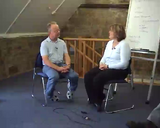using clients' language
The work of Scott Miller, Bruce Wampold and friends emphasise that the therapeutic alliance is one of the most important factors leading to clinical efficacy.
Their work also invites us to explore the massive 87% of outcome measures as being due to client factors - nothing to do with the therapy itself
These compelling reasons require our investigation into how we might harness the therapeutic alliance and client factors and so add to our work practices, and to client outcomes.
One of the ways of creating a trusting relationship, adding to the therapeutic alliance and connecting with the client factors is to speak their language.
I like to make careful note of any key words any client may use,
the way they pronounce them such as dance, envelope,
the “dialect’ they use,
whether they “see”, “feel”, “hear” or occasionally “taste” or “smell”
People who “see” want clarity or focus
Those who “feel” may want to come grips or grasp a solution ...
If someone “hears” that may talk about harmony or discord or getting in tune
A “tasting”person my speak of something being disgusting or leaving a bad taste in their mouth
A “smelling” individual my get a sniff of a solution.
Exercise:
When you are talking with a friend or client, take note of the words they use, the way they pronounce them, and the way they express themselves - through their eyes, ears, etc.





4 comments
Hi rob.. wondering if they say theyre thinking this or that.. could that be usefull too.. or maybe too imposing to use "well i was thinking perhaps..".. just wondering what your "thoughts" are on this .. cheers.. more good info thanks
I've found it can be helpful to say "I was thn iking ..." as long as I follow up by asking "What do you think about that?"
This topic is probably one of my favourites. I love taking notice of people's language and in my coaching program, I have a whole section on language too. Taking notice of what people say, how they say it and mirroring that, builds trust and connection.
Dave Grove a NZ therapist and NLP practioner developed clean language. It
is worth looking into.I just got a book on it. TRUST ME, I'M THE PATIENT by
Philip Harland. Very interesting and very hypnotic approach.
Leave a comment
Please log in or register to post a comment